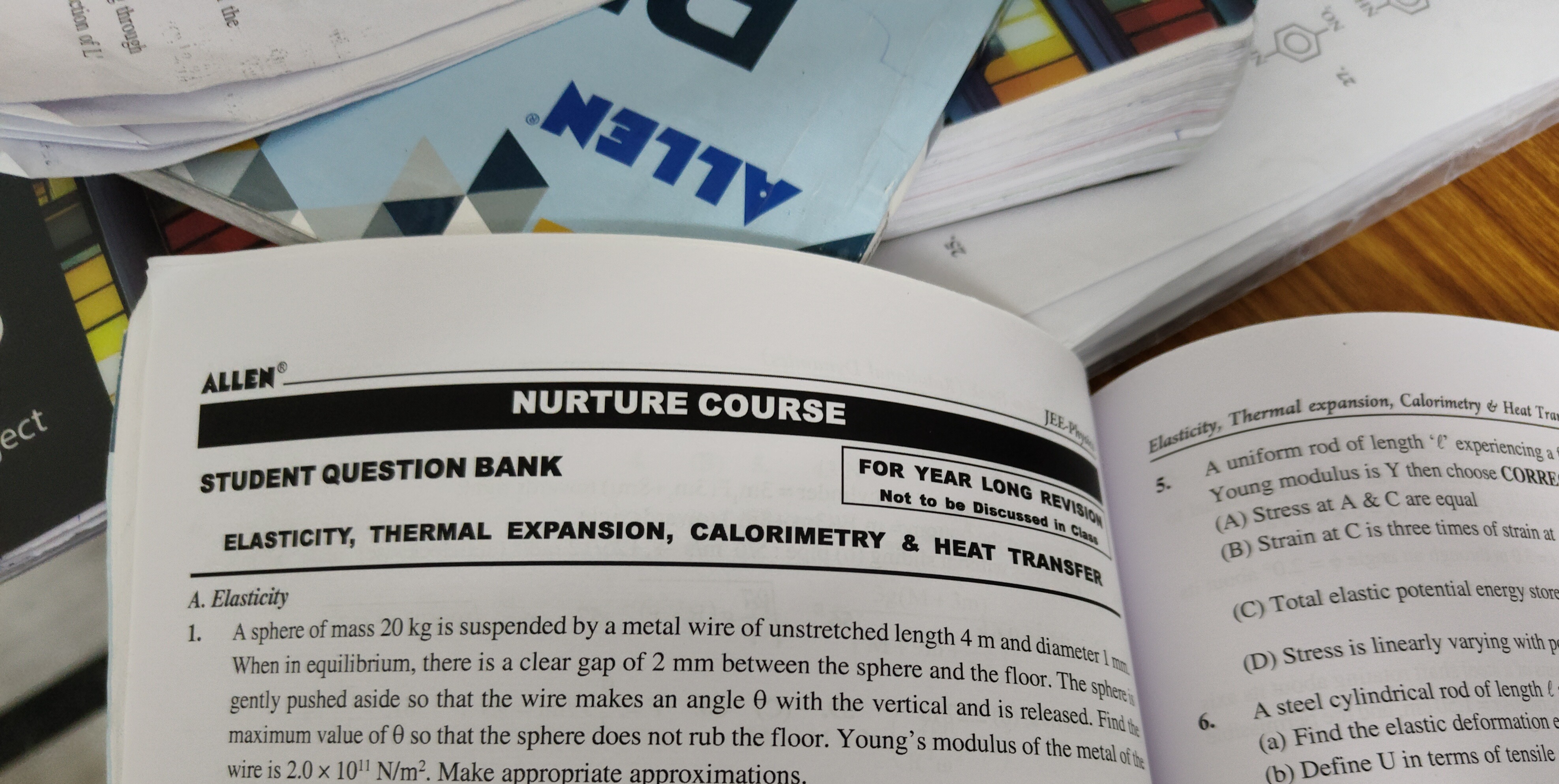Question
Question: A sphere of mass 20 kg is suspended by a metal wire of unstretched length 4 m and diameter 1 mm. Whe...
A sphere of mass 20 kg is suspended by a metal wire of unstretched length 4 m and diameter 1 mm. When in equilibrium, there is a clear gap of 2 mm between the sphere and the floor. The sphere is gently pushed aside so that the wire makes an angle θ with the vertical and is released. Find the maximum value of θ so that the sphere does not rub the floor. Young's modulus of the metal of the wire is 2.0×1011N/m2. Make appropriate approximations.

The problem as stated is ill-posed, as the minimum height of the sphere above the floor is 2 mm, meaning it never rubs the floor. If interpreted as the sphere just touching the floor at maximum displacement, it leads to an impossible physical scenario (cosθ>1).
Solution
The problem describes a sphere suspended by a wire, forming a pendulum. In equilibrium, the wire has an unstretched length L0=4 m and an extension ΔL0 due to the weight of the sphere. The gap between the sphere and the floor in equilibrium is hfloor=2 mm.
-
Calculate Equilibrium Extension (ΔL0):
- Mass of sphere, m=20 kg
- Young's modulus, Y=2.0×1011 N/m2
- Diameter, d=1 mm =1×10−3 m ⟹ Radius, r=0.5×10−3 m
- Cross-sectional Area, A=πr2=π(0.5×10−3)2=0.25π×10−6 m2
- Tension in equilibrium, T0=mg=20×9.8≈200 N (using g≈9.8 m/s2 or 10 m/s2). Let's use g≈10 m/s2 for simplicity as approximations are allowed. T0=200 N.
- Extension: ΔL0=AYT0L0=(0.25π×10−6 m2)(2.0×1011 N/m2)(200 N)(4 m)=0.5π×105800=π1600×10−5 m.
- Using π≈3.14, ΔL0≈3.141600×10−5≈509.6×10−5 m ≈5.1 mm.
-
Analyze Sphere's Height:
- The equilibrium length of the wire is Leq=L0+ΔL0=4 m+5.1 mm≈4.0051 m.
- Let the suspension point be O. The distance from O to the floor is Htotal=Leq+hfloor=(4.0051 m)+(2×10−3 m)≈4.0071 m.
- When the wire makes an angle ϕ with the vertical, the length of the wire is approximately Leq (since ΔL0≪L0, the change in length due to tension variation is negligible for this approximation).
- The vertical distance from O to the sphere at angle ϕ is Leqcosϕ.
- The height of the sphere from the floor is h(ϕ)=Htotal−Leqcosϕ=(Leq+hfloor)−Leqcosϕ.
-
Condition for Not Rubbing the Floor:
- The sphere does not rub the floor if h(ϕ)≥0 for all angles ϕ during its swing.
- The minimum height occurs at ϕ=0 (the lowest point of the swing).
- hmin=h(0)=(Leq+hfloor)−Leqcos0=(Leq+hfloor)−Leq=hfloor.
- Since hfloor=2 mm, which is greater than 0, the minimum height of the sphere above the floor is 2 mm.
-
Conclusion:
-
Because the minimum height of the sphere from the floor is always positive (2 mm), the sphere never rubs the floor, regardless of the initial angle θ from which it is released.
-
Therefore, any angle θ is permissible under the condition "does not rub the floor".
-
Possible Misinterpretation: If the question intended to ask for the maximum angle θ such that the sphere just touches the floor at this maximum angle, then h(θmax)=0. (Leq+hfloor)−Leqcosθmax=0 Leqcosθmax=Leq+hfloor cosθmax=1+Leqhfloor=1+4.0051 m2×10−3 m≈1+0.0005. This leads to cosθmax>1, which is physically impossible.
-
The problem statement, as given, leads to the conclusion that the sphere never rubs the floor. This suggests either the question is flawed, or it's a trick question where any angle is valid. Given the context of physics problems, a solvable scenario is usually intended. However, based strictly on the wording, the condition is always met.
-
